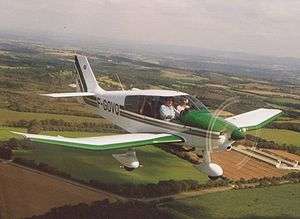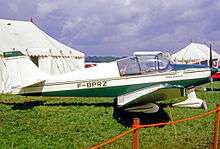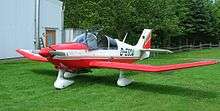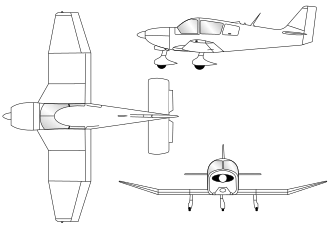Robin DR400
The Robin DR400 is a wooden sport monoplane, conceived by Pierre Robin and Jean Délémontez. The Robin DR400 first flew in 1972 and is still in production. The current model is designated 'DR401'. It has a tricycle undercarriage, and can carry four people. The DR400 has a 'cranked wing' configuration, with the dihedral angle of the outer wing much greater than the inboard, a configuration which they share with Jodel aircraft. This model is considered easy to fly by many and quiet during flight due to its wooden frame.
| DR400 | |
|---|---|
 | |
| DR400/160 Major | |
| Role | Four-seat light aircraft |
| Manufacturer | Avions Pierre Robin |
| First flight | 1972 |
| Number built | 1292+ |
| Developed from | Robin DR.200 |
| Variants | Robin DR500 |
Development
The Robin DR300 series were developments of the earlier DR.221 Dauphin and DR.250 Capitaine with a tricycle landing gear. The first variant was the DR340 Major, a tricycle landing gear version of the DR250 Capitaine which first flew on 27 February 1968, followed on 21 March 1968 by the DR315 Petit Prince, a tricycle landing gear version of the DR221 Dauphin. The DR315 was later replaced by the DR300. In 1972 an improved version, the DR400 was introduced with a forward-sliding canopy.
Design

The wing is a distinctive feature of the Robin DR400, and is what immediately separates this aircraft visually from other similar light aircraft. It is a derivative of the earlier Jodel designs, is light, stiff and strong, with the dihedral of the outer panels imparting substantial lateral stability in flight. Being fabric covered, it presents a smooth surface to aid airflow, unhindered by the typical overlapping panels or rivets found on metal aircraft.
The secret to the DR400's relatively high performance lies in the pronounced washout in the outer panels. Since they have a lower angle of attack to the airflow than the centre section, they create less drag in cruise flight. This characteristic also imbues rather benign stall behavior and the DR400 consequently does not suffer from the need to install retro-fixes like leading edge stall strips.
Variants
- DR315 Petit Prince
- A development of the earlier DR221 with a tricycle landing gear and powered by a 115hp Lycoming O-235-C2A engine.
- DR330
- An experimental DR.315 fitted with a 130hp Continental O-240-A engine in 1970.
- DR340 Major
- A development of the earlier DR250 with a tricycle landing gear and powered by a 140hp Lycoming O-320-E2A engine.
- DR360 Chevalier
- DR340 with a solid cabin roof and a 160hp Lycoming O-320-D2A engine.
- DR300/108 2+2
- Replacement for the DR.315 with improved landing gear and either two or four seats.
- DR300/120
- Four-seat DR.300 with a 120hp Lycoming O-235-L2A engine.
- DR300/140
- DR300 with a 140hp Lycoming O-235-E2A engine.
- DR300/180
- DR300 with a 180hp Lycoming O-360-A3A engine.

- DR300/180R
- Glider tug version of the DR.300-180.
- DR400/100 Cadet
- Two-seat version of the DR.400-108
- DR400/108 Dauphin 80 2+2
- DR300/108 with forward-sliding canopy
- DR400/120 Petit Prince
- DR300/120 with forward-sliding canopy
- DR400/120 Dauphin 2+2
- Petit Prince with extra cabin windows.
- DR400/125
- DR400/120 with a 125hp Lycoming O-235-F engine
- DR400/140 Earl
- DR300/140 with forward-sliding canopy
- DR400/140B Major 80
- DR400/140 with a 160hp Lycoming O-320-D2A
- DR400/160 Chevalier
- Original designation for the DR400-140B
- DR400/180 Regent
- DR300/180 with forward-sliding canopy, later models have extra cabin windows.
- DR.400/180 Regent III
- A Nouvelle Generation DR400
- DR400/180R Remorqueur
- DR400/180 glider tug with clear canopy
- DR400/180RP Remo 212
- DR400/180R fitted with a 212hp Porsche PFM 3200 engine and 3-bladed propeller
- DR401
- Supplied by the resurrected Robin Aircraft. Glass cockpit, larger cockpit, electric trim and flaps, range of engine options, variants for "long range" and "aerotow".[1]
Specifications (DR400/180 Régent)

Data from Jane's All the World's Aircraft 1976–77[2]
General characteristics
- Crew: 1
- Capacity: 3–4 passengers
- Length: 6.96 m (22 ft 10 in)
- Wingspan: 8.72 m (28 ft 7 in)
- Height: 2.23 m (7 ft 4 in)
- Wing area: 14.20 m2 (152.8 sq ft)
- Airfoil: NACA 23013.5 (modified)
- Empty weight: 600 kg (1,323 lb)
- Max takeoff weight: 1,100 kg (2,425 lb)
- Fuel capacity: 190 L (42 imp gal; 50 US gal) normal, 240 L (53 imp gal; 63 US gal) with auxiliary tank
- Powerplant: 1 × Lycoming O-360-A air-cooled flat-four piston engine, 130 kW (180 hp)
- Propellers: 2-bladed Sensenich metal fixed-pitch propeller, 1.93 m (6 ft 4 in) diameter
Performance
- Maximum speed: 278 km/h (173 mph, 150 kn) at sea level
- Cruise speed: 249 km/h (155 mph, 134 kn) at 12,000 ft (3,660 m) (econ. cruise)
- Stall speed: 95 km/h (59 mph, 51 kn) (flaps down)
- Never exceed speed: 308 km/h (191 mph, 166 kn)
- Range: 1,470 km (910 mi, 790 nmi)
- Service ceiling: 4,720 m (15,490 ft)
- Rate of climb: 4.19 m/s (825 ft/min)
- Takeoff run to 15 m (50 ft): 610 m (2,000 ft)
- Landing run from 15 m (50 ft): 530 m (1,740 ft)
References
- DR401 the next DR400 generation Archived 2015-09-24 at the Wayback Machine robin-aircraft.com Retrieved 29 August 2015
- Taylor 1976, pp. 60–61
| Wikimedia Commons has media related to Robin DR400. |
- Exavia Ltd (Exeter, United Kingdom)- article "A DR400 Buyers' Guide"
- The Illustrated Encyclopedia of Aircraft (Part Work 1982-1985), 1985, Orbis Publishing, Page 2799
- R.W.Simpson, Airlife's General Aviation, Airlife Publishing, England, 1991, ISBN 1-85310-194-X
- Taylor, John W. R., ed. (1976). Jane's All the World's Aircraft 1976–77. London: Jane's Yearbooks. ISBN 0-354-00538-3.CS1 maint: ref=harv (link)